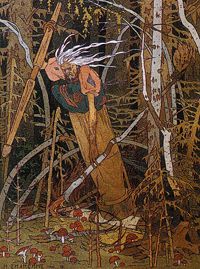Development of a computer-based information system for Russian folklore studies
 Computer
systems SKAZKA and SKAZKA-2 are developing by A.V. Rafaeva. The aim of this work
is to make program tools for structural analysis of folktale plots and motives.
Computer
systems SKAZKA and SKAZKA-2 are developing by A.V. Rafaeva. The aim of this work
is to make program tools for structural analysis of folktale plots and motives.
First, computer system SKAZKA (Folktale) is to be discussed. The system is based on the part of famous folklore index of Aarne and Thompson (AaTh index)[1], it also contains some dictionaries, a lot of additional databases (for example, tale descriptions by Propp’s functions and the index of main semantic oppositions in some folktale types) and can store “history”, i.e. the results of one or more user requests. The main program kit to deal with all the data is Starling program for multilingual database and texts processing, developed by S.A. Starostin (see http://starling.rinet.ru/program.php?lan=en for program and it’s description). Some additional program modules are developed by A. Rafaeva to make and use dictionaries (besides English and Russian-English dictionaries, that are the part of Starling), to make concordances of given word or group of words, to find folklore motives by their keywords and so on.
The SKAZKA system was very useful for structural and semantic analysis of folktales. For example, it was used to explore some motives and their function (disenchantment, the dead bridegroom and others) and to study the relations between parents (especially the role of mother, stepmother and godmother) in tales of magic[2]. Besides, it lets us draw a lot of conclusions about computers systems for folklore studies:
we need different dictionaries and different keyword tables to deal with different folklore genres. For example, fox is helper in tales of magic, but trickster in animal folktales;
many folklore indices can be used as a base of computer system. So, we tried to find the motif dead or supernatural bridegroom, other relative in 8 indices from the site “Folklore and Postfolklore” (http://ruthenia.ru/folklore/)[3]. Thus, full description of plot or motif in the index is more important for automatic processing, than the structure of that index;
more interesting is to study folklore indices and texts together, so we have to develop another computer system for this purpose.
SKAZKA is not supported now, but some of it’s data and results will be used in program tool SKAZKA-2, based on Russian folktales and SUS[4] index.
[1] Thompson S. The Types of the Folktale: A Classification and Bibliography. Anti Aarne's Verzeichnis der Märchentypen. Third printing. Helsinki, 1973. (FFC 184).
[2] See Rafaeva A.V. Poluavtomaticheskij analiz volshebnykh skazor v kompjuternoj sisteme SKAZKA (Semi-Automatic Analysis of Magic Folktales in Computer System SKAZKA) // Trudy mezhdunarodnogo seminara Dialog’98 po kompjuternoj lingvistike i ejo prilojenijam. Kazan, 1998. V. 2. Pp.701 – 706; Rafaeva A.V. Issledovanie struktury volshebnoj skazki metodami komputernoj lingvistiki (Analysis of Magic Folktale Structure Using Computer Linguistic Methods // Tekst. Intertekst. Kultura” Materialy mezhdunarodnoj nauchnoq konferencii. Moscow, 2001. Pp. 112 – 113; Rafaeva A.V. Analiz rodstvennykh otnoshenij s pomosh’ju sistemy SKAZKA (Analysis of Relate Terms with the Help of SKAZKA Program) // Problemy kompjuternoj lingvistiki: Sbornik nauchnykh trudov, 1. Voronezh, 2004. Pp. 83 – 90. (http://www.ruthenia.ru/folklore/rafaeva4.htm) and other.
[3] See Rafaeva A.V. Nekotorye vozmozhnosti kompjuternogo analiza fol’klornykh ukazatelej (Computational Analysis of Folklore Indices: Some Opportunities) // Problemy kompjuternoj lingvistiki, 2. Voronezh, 2005. Pp. 154 – 168. (http://www.ruthenia.ru/folklore/rafaeva5.htm).
[4] Sravnitel’nyj ukazatel’ sujetov: Vostochnoslavjanskaja skazka (Comparative Plot Index: Eastern Slavic Folktales). Leningrad, 1979.